Dancing the Rhythm and Pattern of Life
Lightsey Darst saw the recent fancy dance at the Cowles, by the Native Pride Dancers, and she wonders: "Shouldn't the Twin Cities be able to support a serious Native dance company that can break new ground in presenting this form of dance on stage?"
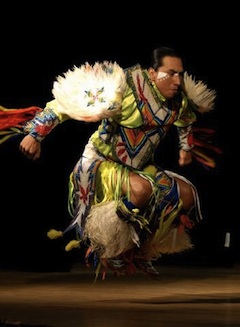
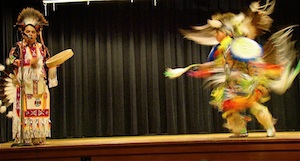
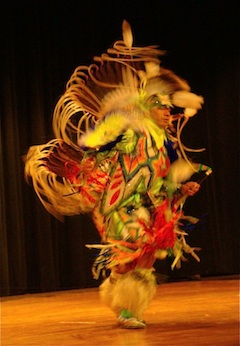
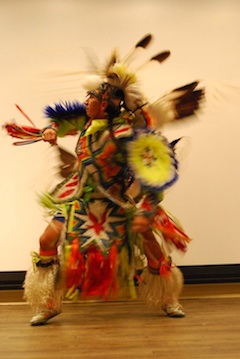
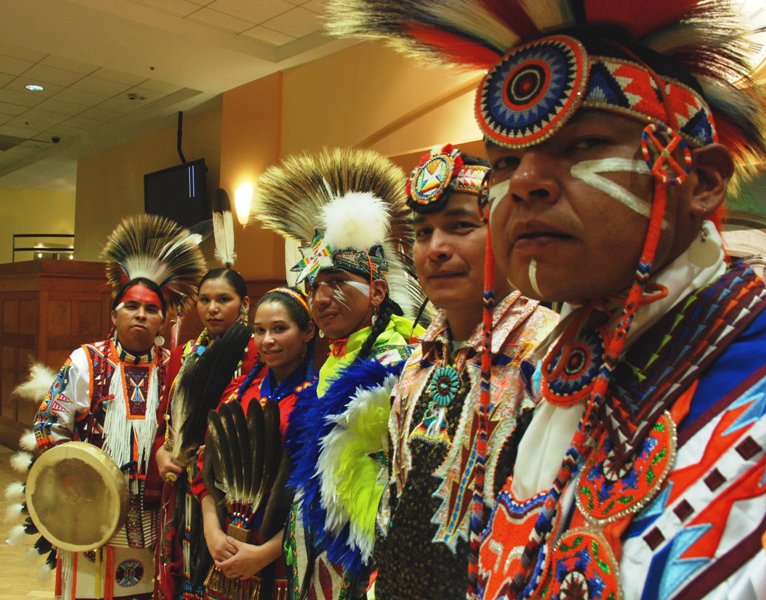
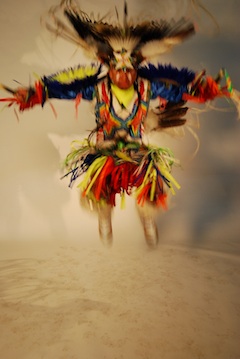
AT THE END OF THIS WEEKEND’S NATIVE PRIDE CONCERT, Native Pride director Larry Yazzie invited audience members on stage to try out some basic steps, setting the whole stage jumping. I was reminded of another piece I saw a while back, BodyCartography’s Incandescent, in which a group mostly of non-dancers jumped up and down until they wore themselves out. The two dances couldn’t be more different. One is the creation of a couple of art-world darlings, thumbing their noses at history and hierarchy by reducing dance, choreography, and dancer to their simplest possible meanings. In the other, dancers dedicated to what dance-wonks call a classical form (a form arising from and expressive of a culture, like ballet or bharatanatyam) let untrained others feel the underlying beat of their dance, a dance in which the entire creation moves to a common pulse. Hmm… Come to think of it, perhaps these two pieces aren’t so different after all.
What linked the two together in my mind, anyway, was the sheer pleasure of seeing everyone bouncing. I would like it if the world really looked that way, buoyant. Perhaps it does through other eyes.
For those who missed it, I feel that I must say this wasn’t a great show. It was more the material of perhaps three great shows, cut up and spread out to make one rambling, confusing, long-feeling evening, with dance, narration, a slideshow, audience participation, and repetitive introductions of each piece. I was told that the night I attended, a storyteller had to pull out at the last minute because of illness; still, it’s hard to imagine that a single person could have unified the evening’s performances.
What I found most puzzling was the sense that this was not a Native Pride concert, but the Native Pride concert. What about exploring an aspect of these forms, telling a story, organizing around a concept? Yazzie and company didn’t seem to think they’d be back at the Cowles; to judge from the sadly slack attendance, maybe they won’t. But this doesn’t make sense. Shouldn’t the Twin Cities be able to support a serious Native dance company that can break new ground in presenting this form of dance on stage? Or, to put the question another way, if Minnesota, with its intense dance scene and prominent Native community, doesn’t foster such a company, who will?
But about the dance:
If you haven’t seen the whirlwind that is fancy dance, it’s hard to describe. The human figure disappears into a blaze of regalia — ribbons, feathers, beads, all swinging, bouncing, flashing. The dancer bobs and struts with his head forward like a game bird, while his wide-placed feet keep the rhythm and his arms balance as if he were about to pounce. The matching dance for women, the fancy shawl dance, sends the dancer whirling while her feet prance and kick high. She holds her fringed shawl out like the wings of a butterfly, as she reels across the space. Arlan Whitebreast and Shyama-Primya faced off, trading beats; you could keep score, or you could just unfocus, and let all the color and motion roll over you.
Lane Brian Jensen’s hoop dance won the largest applause of the evening. Smaller than a hula hoop but large enough to move over the dancer’s body easily, the flexible hoops seemed to float up and around, Jensen somehow not tripping as, constantly moving, he picked them up and played with them, adding one each time. Four hoops made a cage seat; five made wings; six made a shield. I’m not sure how many made the globe that Jensen wore, then slipped off and set on the stage like a new-made world.
Jennie Kappenman’s jingle dress dance was my own favorite. The jingle dress, its skirt beaded with tiny metal cones that rattle and reflect light, came to a shaman in a dream as a cure. The dance itself is sprightly but dignified. Kappenman moved on her toes, her thumbs neatly tucked into her belt, her back ramrod straight while her long braids swung around her, her gaze neither quite here nor in another world, her face serene. I didn’t know I was ailing until I felt cured.
______________________________________________________
What I found most puzzling was the sense that this was not a Native Pride concert, but the Native Pride concert. What about exploring an aspect of these forms, telling a story, organizing around a concept?
______________________________________________________
One dance, an older women’s style, initially didn’t seem stage-ready. Autumn Sunset Keahna didn’t do much, to a viewer brought up on European dance; she simply bobbed up and down, her knees bending deeply, but her slippered feet not quite leaving the floor and never separating, her arms just beginning every now and then to come away from her body. But as I watched her, I noticed how much attention she paid to where she was going, how deliberate all her little angling turns were. It was as if she were tracing a pattern in the floor, a pattern I couldn’t see. No, come to think of it, not in the floor — beneath the floor, barely legible to her in the smothered earth.
AFTER THE GROUP DANCE, Yazzie picked a breathless young woman to interview. “Have you ever danced with Indians before?” he asked. “Never!” she said. “How does it feel?” he asked. She took a breath. “Euphoric!”
If Yazzie hadn’t been Native, the encounter would have been ridiculous — like an eager news reporter out for a human interest bit, or a game-show host toying with the contestant who’s won the grand prize, asking the plucky white girl, “And have you ever danced with Indians before?” as if it were akin to swimming with dolphins or running with the bulls, as if there weren’t enough Native Americans in Minnesota that she probably had danced with Indians somewhere before, at a wedding, a high school prom, at First Avenue.
Yet maybe swimming with dolphins isn’t an entirely ridiculous comparison. Native dances do try to connect to the natural world; they imitate animal behavior. The eagle dancer looks surprisingly like an eagle as he angles his wings; the fancy-dancer resembles the ruffled grouse; the fancy shawl dancer flits like a butterfly. Is the relation of these dances to the natural world touristic? My instinct says no: what these dances catch is an underlying pattern and rhythm that rings true.
______________________________________________________
Noted performance details:
Larry Yazzie and the Native Pride Dancers performed at the Cowles Center for Dance and the Performing Arts in Minneapolis, Friday and Saturday, October 14 & 15.
______________________________________________________
About the author: Originally from Tallahassee, Lightsey Darst is a poet, dance writer, and adjunct instructor at various Twin Cities colleges. Her manuscript Find the Girl was recently published by Coffee House; she has also been awarded a 2007 NEA Fellowship. She hosts the writing salon, “The Works.”